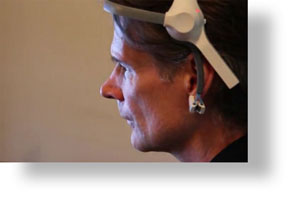
The following is some tech info for those of you who are interested in the science behind the brainwave tools that we offer at WujiTech such as the WujiBrainwave app and our MindMedia
Brainwaves are the five main frequency bandwidths of brainwave output that we are recording from the User as follows:
- Delta Range - 0.5 to 4 HZ (associated with deep sleep and relaxation)
- Theta Range - 4 HZ to 8 HZ (seen in dreaming sleep, and other mental states where the mind is wandering, like daydreaming and imagining)
- Alpha Range - 8 to 13 HZ (relaxed but awake, body awareness)
- Beta Range - 13 HZ to 30 HZ (normal, active awake state/aware)
- Gamma Range - 30 HZ to 60 HZ (high frequency, pleasurable state of being)
In the WujiBrainwave app, the Helical Meters represent visual feedback of the particular brainwave bandwidths of your brain's activity in real time. We segment the overall brainwave spectrum into the traditional Delta, Theta. Alpha, Beta, and Gamma bandwidths. The percentage number at the bottom of the Meter shows the amplitude of your brainwave output - it is a % of the possible signal strength your brain can generate using this hardware. The number at the top of the Meter shows the number of total seconds that you sustained more than 50% amplitude during your session. The time you spend above the halfway mark is statistically valid as it shows you were able to increase your brainwave output in that region above average. This can be consciously done as you practice - or unconsciously done (which gives you the opportunity to better understand, with continued practice, how to bring that into conscious control. Enjoy exploring your brain and it's potential for your health and personal empowerment.
Another way to observe your brainwave output (the electrical energy that your brain is actually generating based on your thinking and various physiological functions) is by looking at the Algorithm Meters on the right side of the screen. They are labeled to describe the most “common” aspects of your brain function. Our “algorithms” are patented combinations of different brainwave activity – when your brain matches that particular combination, the meter grows to the left. You may not always “agree” with what you feel, but be patient and take time to explore and try this app at different times of the day or when you are in different moods. Words like “meditation” mean different things for different people… For us, “deep meditation” has less “focus and attention” and displays more of a softer, low-frequency brainwave activity. Other algorithms such as “Schumann Resonance” are scientifically accepted frequencies of brainwave output. Our Schumann Resonance Algorithm equals 7.83 Hz – one of the many spectral peaks in the global electromagnetic field of planet earth. Practicing to raise this particular Meter in the WujiBrainwave app will help you connect with grounding “earth energy” that many believe is calming and harmonizing.
Be sure to click on "View My Brainwave Session Records" at the left to see the graphical results of your saved WujiBrainwave Sessions at Brainwave.WujiTech.com so you can see how your brain responded according to the above Meters.
Remember that you can use your Username and Login to access your account and personal WujiDashboard for an array of social networking and support tools at www.Brainwave.WujiTech.com
 Studies have confirmed findings and revealed a variety of neural signatures of flow. Chris Berka and her colleagues at Advanced Brain Monitoring in Carlsbad, California, for example, looked at the brain waves of Olympic archers and professional golfers. A few seconds before the archers fired off an arrow or the golfers hit the ball, the team spotted a small increase in what's known as the alpha band, one of the frequencies that arises from the electrical noise of all the brain's neurons (The International Journal of Sport and Society, vol 1, p 87). This surge in alpha waves, Berka says, is associated with reduced activation of the cortex, and is always more obvious in experts than in novices. "We think this represents focused attention on the target, while other sensory inputs are suppressed," says Berka. She found that these mental changes are accompanied by slower breathing and a lower pulse rate - as you might expect from relaxed concentration.
Studies have confirmed findings and revealed a variety of neural signatures of flow. Chris Berka and her colleagues at Advanced Brain Monitoring in Carlsbad, California, for example, looked at the brain waves of Olympic archers and professional golfers. A few seconds before the archers fired off an arrow or the golfers hit the ball, the team spotted a small increase in what's known as the alpha band, one of the frequencies that arises from the electrical noise of all the brain's neurons (The International Journal of Sport and Society, vol 1, p 87). This surge in alpha waves, Berka says, is associated with reduced activation of the cortex, and is always more obvious in experts than in novices. "We think this represents focused attention on the target, while other sensory inputs are suppressed," says Berka. She found that these mental changes are accompanied by slower breathing and a lower pulse rate - as you might expect from relaxed concentration.
http://www.newscientist.com/article/mg21328501.600-zap-your-brain-into-the-zone-fast-track-to-pure-focus.html?page=1


